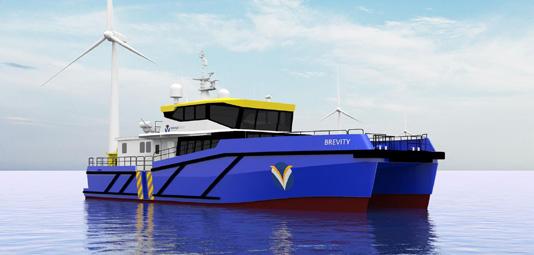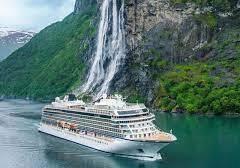
4 minute read
Chartwell in Asia
Strategic Marine has signed an order to build three ‘Brevity’class crew transfer vessels (CTVs) from Chartwell Marine.
The Brevity-class 27-metre catamaran design forms part of Chartwell’s new offshore wind support vessel range, which has seen multiple orders in the UK and USA since its launch in June 2022.
“We’ve been keen to tap into the Asian market as part of our global expansion,” said Rob Sime, principal naval architect at Chartwell Marine.
“Strategic Marine is a key player in the region and we’re proud to be able to work with them on our own designs, alongside their current CTV roster. Our offshore wind range is built to be a one-stop-shop to meet the varying and increasingly complex needs of the industry and we hope we can offer some of that support to the ongoing growth of green energy in Asia.”
Cost efffective
Strategic Marine said that the Brevity responds to the need in the offshore wind support market for a high-powered CTV capable of cost-effective and lowemissions operation.
The Brevity class boasts enhanced manoeuvrability and stability due to its signature hull form optimisation and has a capacity of 32 personnel. Multiple crew configurations enable flexibility in space planning and enhance comfort necessary for longer offshore stays.
“Strategic Marine is committed to building vessels that will
BRIEFS
New workboat berth
Inland and Coastal Marine Systems will build seven 100-tonne concrete breakwater pontoons at for the busy harbour of Dover in southern England. A bespoke design has been created so that the units are strong enough to accommodate workboats and large, commercial vessels for all-year berthing and water access for crews. The work will include floating foam fenders and M&E services.
CHARTWELL INKS FIRST VESSEL PROJECT IN ASIA
Credit: Chartwell Marine
accelerate the growth of the offshore wind industry,” said Chan Eng Yew, CEO of Strategic Marine. ”The quality of our materials and expertise go hand in hand with Chartwell’s design philosophy of efficiency and
8 The Brevity-class 27-metre
catamaran design forms part of Chartwell’s new offshore wind support vessel range
adaptability. We are confident of their ability to deliver on both and it is important that we continue to diversify our build strategies; both to capitalise on growing demand for specialised vessels and to catalyse innovation in the CTV sector as Asian renewables evolve at pace alongside it.”
Chartwell’s three Brevity CTVs are meant for a new client for the Singapore based shipbuilder. As the first Chartwell project to be launched in Asia, the Brevity trio will enter an exciting new proving ground in the continent’s offshore wind support market.
The International Renewable Energy Agency estimates that by 2050, Asia will account for over 60% of all offshore wind capacity installed globally.
FIRST CRUISE SHIP TESTS ON BOARD HYDROGEN
Ship owner Viking has had its latest cruise ship, Viking Neptune, delivered to its shipyard in Ancona after being built by Italian firm Finacantieri.
The 47,800-tonne, 465-cabin small cruise ship ’marks a quantum leap in the longstanding cooperation between Viking and Financantieri for deisgning, delivering and operating environmentally considerate cruise vessels’, Fincantieri says - because it is the first to have a hydrogen fuel cell incorporated in its design.
The 100kW cell has been fitted as a test as a move towards increasingly bringing hydrogen on board, and will power some of the onboard operations on the boat.

8 Viking Neptune will test a
hydrogen fuel cell
”Such installation is particularly important for tuning technological devices and developing rules and regulations for use of hydrogen on board a cruise vessel,” the company says.
Viking and Fincantieri aim to develop large-scale hydrogen applications and as a first step they have designed an enlarged vessel configuration that will be applied to all vessels deliveered after 2024, with a focus on accommodating the larger size of the hydrogen tank, fuel cell systems and auxiliary equipment.
“The second step will be the development of a hydrogenbased generation system with a total power of about 6-7MW, and able to ensure smokeless port operation and slow steaming navigation,” the firms say, adding that once they have been proved, these systems could be retrofitted on some vessels already delivered.
Viking Neptune is the 15th ship added to Viking’s fleet this year alone, which is also the company’s 25th anniversary.
Damen expansion
Dutch shipbuilder Damen will invest in new repair facilities and a 150-tonne ship lift at one of its 35 shipyards, Gorinchem, it says. All staff will move from the Hardinxveld-Giessendam shipyard, which will be sold, an employee said. The new yard will be an optimal location for repair and build of ships of up to 90m, Damen says. “We are seeing how, in the future, more work will be done for Dutch customers in the Netherlands,” said managing director Jos van Woerkum.
Rovco signs MoU
Subsea robotic and hydrographic survey firm Rovco will assist Horizon Ocean Management in analysing the potential for offshore wind in Japan, where the industry is still emerging. 3D assessments will be carried out along with data analysis to determine potential issues in maintaining wind farms as well as planning their development. Japan has recently announced ambitious plans to expand the sector.
€2.2m pier protection
A project to protect a centuryold pier at the ABP-owned Port of Lowestoft in the UK is about to complete. Red7Marine carried out underwater dive surveys before installing a sheet pile wall using 100 sheet pile pairs spanning 140 metres. Using its 250t deck capacity Haven Seariser 3 jack-up barge with 35t excavator, the firm removed several timber piles, concrete and metal before installing the new pile wall using the flat top barge Haven SeaStabler.









